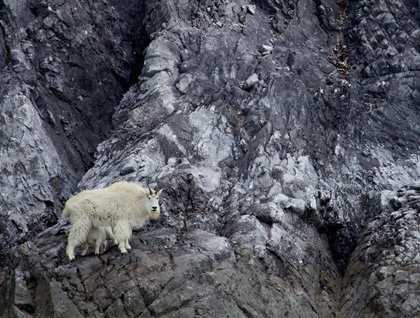In the early hours of the morning, the National Geographic Sea Lion entered Glacier Bay National Park, picked up Park Ranger Randy Thomas and Huna cultural interpreter William Horton-Garrison (Tyuknuk), and proceeded north into the bay. At over 3 million acres, Glacier Bay National Park is the size of Connecticut and protects dramatic glacial fjords, calving tidewater glaciers, sweeping vistas, intact ecosystems, an ancestral homeland for the Tlingit people, and a huge diversity of plants and wildlife.
Our day started off with a bang as we left breakfast to be smacked in the nose by the pungent fragrance of a sea lion haul-out on South Marble Island. Puffins flew to nesting burrows with small fish clamped in their bills; black-legged kittiwake gulls squabbled on cliff ledges; pigeon guillemots peeped from the low rocks. One of the best areas to see nesting seabirds in the region, we were treated to South Marble’s abundant life, including sea otters and a handful of humpback whales sounding in front of the stunning peaks of the Fairweather range.
Randy and William presented a formal welcome to Glacier Bay, telling the story of Glacier Bay’s unusual past. William’s ancestors lived in Glacier Bay for thousands of years, establishing homes and a rich culture in the shadow of ice. A few hundred years ago, however, the large glacier which at that time filled most of Glacier Bay moved rapidly downhill, pushing the Tlingits from their villages and forcing them to relocate to the present-day town of Hoonah. The Glacier Bay we saw today did not exist back then, as it was buried under thousands of feet of slow-flowing glacier ice. In 1794 Captain George Vancouver charted the area, sending out small boats from his anchorage in Port Althorp, where the Sea Lion was anchored yesterday. Vancouver’s men entered the mouth of Glacier Bay but were almost immediately met by a wall of glacier ice hundreds of feet tall. The great glacier was calving ice into the water where we were watching whales last night, thus earning that area the name Icy Strait. Over the past couple hundred years this massive glacier retreated in what is today known as the fastest glacial retreat in modern history, exposing a scoured moonscape of bedrock and rubble. Coming here today we witnessed the dynamic process of plant succession and have enjoyed fantastic views of wildlife following the vegetative and seafood buffet.
As we came onto the bow after the presentation we were treated to a black bear ambling down the beach, winding in and out of sitka alders and scratching its head against a log. More bear sightings followed: a second black bear grazing high on a hill, a sleeping brown bear sprawled on a beach, a potential mating pair of brown bears high on a mountain slope, a brown bear strolling through beach meadows. An eagle nest, complete with two adults standing guard, graced a spruce tree on Gloomy Knob while low on a steep cliff face a nanny mountain goat licked salt from the tide line and her kid nursed.
William and Randy delivered thought-provoking programs on history, culture, and ecology, and after lunch we had an hour in front of the 250-foot tall Margerie Glacier. Ice calved in booming “white thunder” under a steely sky and we had views of high peaks above the ice. The two-mile-wide Grand Pacific Glacier stood at the head of the bay, blanketed under a thick layer of rocks and providing views up the ice into Canada.
The remainder of the afternoon was spent sailing south back to the entrance of the park, where guests disembarked after dinner at Bartlett Cove. Here they had the opportunity to walk a loop trail/boardwalk along the flowering beach fringe and young spruce/hemlock forest. Hermit thrushes sang from the trees and beautiful reflections were enjoyed in the ponds along the trail. After a visit to the Glacier Bay Lodge, one of the “great lodges of the national parks,” guests returned to the Sea Lion for a sunset departure from Glacier Bay.







